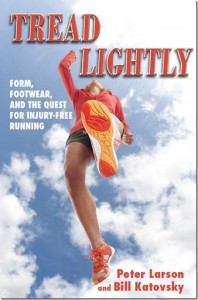Overuse injuries are a reality for hundreds of thousands of runners every year. Is it even possible to prevent running injuries?

That’s the question that Dr. Peter Larson and his coauthor Bill Katovsky explored in their book Tread Lightly: Form, Footwear, and the Quest for Injury-Free Running.
I firmly believe that humans are physiologically designed to run due to the adaptations we have:
- An enormous achilles tendon that absorbs energy to release during the running stride (it’s virtually non-existent in chimps)
- A (mostly) hairless body and highly evolved sweat system to run in the heat – perfect for persistence hunting
- A huge butt! Humans’ gluteus maximus is “a running muscle” according to Harvard professor Daniel Lieberman
- A nuchal ligament that attaches the upper vertebrae to the skull (it keeps our head from rolling around as we run)
But if we’re so adapted to distance running, why do so many runners always get hurt?
The answer may be because of two issues:
- Our running form is poor
- Our running shoes further promote sloppy form
Larson and Katovsky explore these two issues in their book Tread Lightly. Today I want to highlight just a few lessons and ideas that they researched – and how you can use this book to become a healthier runner.
Motion Control for Over-Pronators?
There are literally hundreds of injury prevention suggestions in Tread Lightly that were fascinating to me. I can’t list all of them so I’m going to highlight one that stood out from the rest because many runners get it wrong.
Motion control shoes cause injuries! There are nuances to every “rule” but in general, motion control shoes don’t protect you from injury. One cited study showed a “greater number of injured runners” who wore motion control shoes than neutral or stability shoes.
Further, every runner in the “highly pronated” group who wore motion control shoes reported an injury. Yes…you read that right. Straight from the book:
All runners (yes, all of them…100 percent!) who were supposed to be wearing a motion control shoe based on their degree of pronation got injured… In fact, highly pronated runners actually fared better in neutral shoes! …Motion control shoes offered little benefit to the runners in the study, and in fact were more likely to cause pain and injury than any of the other shoe types. The authors themselves conclude, ‘This study is unable to provide support for the convention that highly pronated runners should wear motion control shoes.'”
As someone who once wore ASICS Kayano’s (and had achilles tendonitis and plantar fasciitis), my personal anecdote supports this conclusion. The current system of assigning a shoe type based on the degree of pronation is woefully outdated. If you want to read more about this specific study, Peter Larson has a post on his blog about the pronation control paradigm.
Most runners will fare best in either neutral or stability shoes from an injury perspective. Experiment with several shoe types (I run in several good options listed on my running resources page) to find what works best for you and is most comfortable when you run.
Instead of relying on bulky running shoes to stabilize your foot and leg while running, your own musculature should be doing the job. Even if you have a flat arch or “floppy” feet, you don’t need a lot of support if you can stabilize yourself with your foot and leg muscles while you run.
Tread Lightly offers several suggestions for strengthening your feet and developing good balance, both crucial to injury-prevention (not motion control shoes):
- Practice standing on one leg
- Use a balance board
- Skateboard (My view: be cautious… there are better alternatives)
Does “Good” Running Form Even Exist?
The authors have three chapters dedicated to running form, focusing on pronation, foot-strike, and “the running stride.” Below is just a fraction of the helpful advice contained in the book.
Running form is variable! You don’t have to label yourself a forefoot, midfoot, or heel striker. You can be all three depending on your shoes (or lack thereof), the terrain, and your speed.
Many runners try to change their form for one reason or another when it’s not even necessary. If you’re running well and you don’t have frequent injuries, there’s no need to alter what’s already working. Doing so could create issues where they didn’t exist before.
There are, however, a few key ways to upgrade your form if you think it needs improving:
- Prevent over-striding by increasing your step-rate (the number of steps you take per minute) by 5-10% from your baseline step rate. This usually solves most cases of over-striding.
- Avoid aggressive heel-striking – the “extended leg, nearly locked knee, toes pointing to the sky at contact kind of gait.” Heel striking isn’t necessarily all bad, but the heel smashing variety can certainly do some damage.
- Shoes affect your form but that’s not a bad thing. Choose shoes that are comfortable to run in (not just stand in) and don’t be afraid to experiment with what works for you.
Always be gradual, progressive, and cautious when making changes to your running form. It takes your body time to adapt to any new stress – typically longer than you think.
A Fresh Look at Injury Prevention
Instead of touting the 10% rule of increasing mileage or the “easy-hard-easy” pattern of training (which, of course, have some value), Tread Lightly offers more valuable injury prevention suggestions that you can implement in your own training immediately.
These are strategies that I’ve learned over my 14+ years of training – many times the hard way – and many of them have helped me stay injury-free for over three years.
- Rotate several pairs of shoes to allow your feet and legs to experience different stresses. Using a mix of shoes (like a distance, trail, and minimalist shoe) might help reduce overuse injuries
- Run more trails. Trail running puts you on uneven terrain and makes your legs work in different ways – breaking the repetitive stress cycle. It can also make your legs stronger and more resilient to overuse injuries.

- Plan variety in your training! Avoid running the same route, over the same distance, at the same pace, in the same shoes on ever run. As your runs get more repetitive, you’ll experience the same repetitive stresses and likely more injuries.
- Low-impact cross training helps. Cycling, pool running, or a gym workout save your body from the repetitive impact of running and can further boost your fitness.
- Rest when you need it. I know, this isn’t a novel idea. But most runners stick to their plan even though they shouldn’t – rest is sometimes the best “workout” for your body. Learn to tell the difference between soreness, pain, fatigue, and an injury.
It’s important to understand that injuries do happen. Since they’re caused by repetitive stress it’s a natural result from competitive running. If your goal is to set a new PR or qualify for Boston, you’ll have to subject your body to a lot of repetitive stress. That’s not necessarily a bad thing – just be cautious and heed the advice in Tread Lightly.
Smart training and knowing your limits are probably your two best injury prevention tools. To better understand the biomechanics of injuries – or if you just want to know more about the relationship between shoes, form, and injuries – you have to read the whole book. I highly recommend it – you can check it out on Amazon here.
I’ll end with some advice from the authors that I found simple and refreshing:
Running should be enjoyed, not painfully endured. Running is in all of our DNA. So listen to your body, respect its needs, and treat it well. In turn, your body will ensure that running is the gift that keeps on giving.